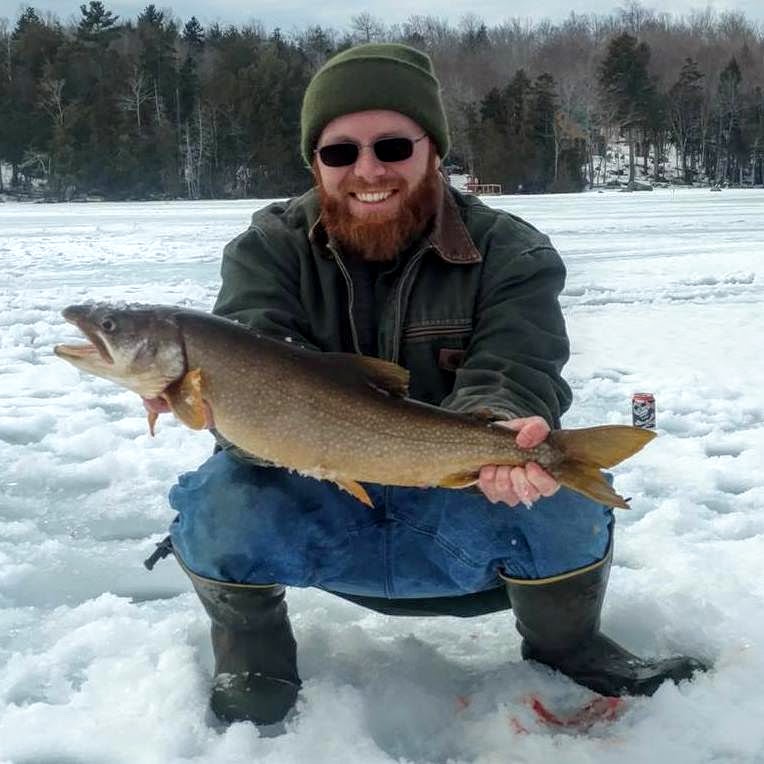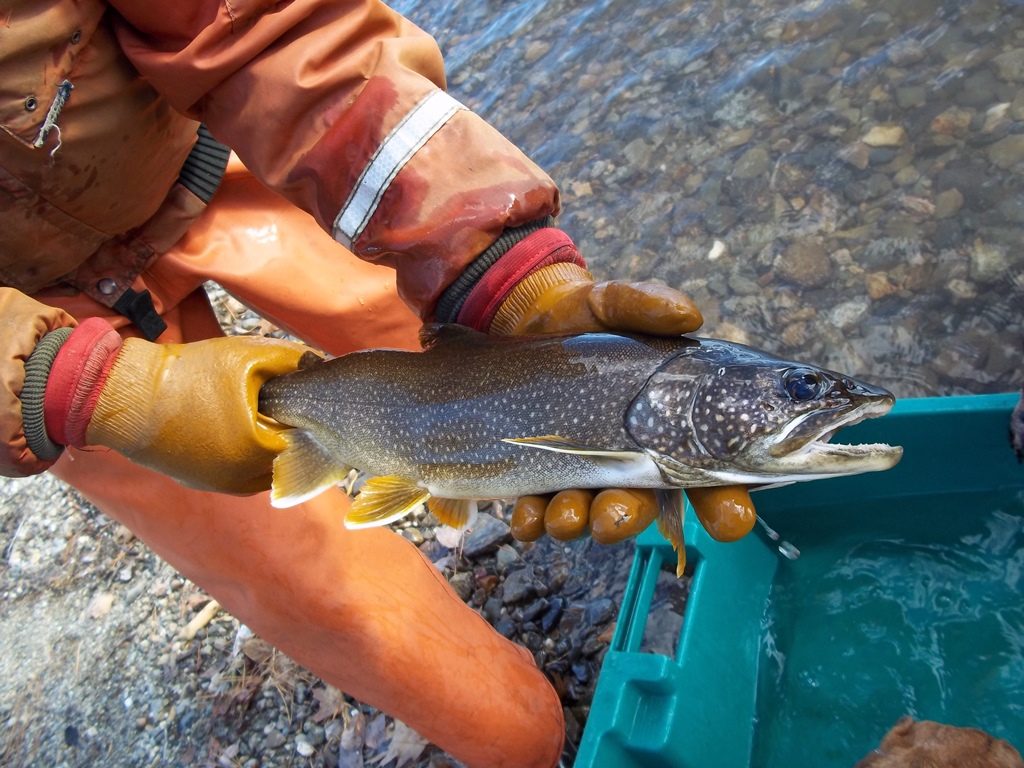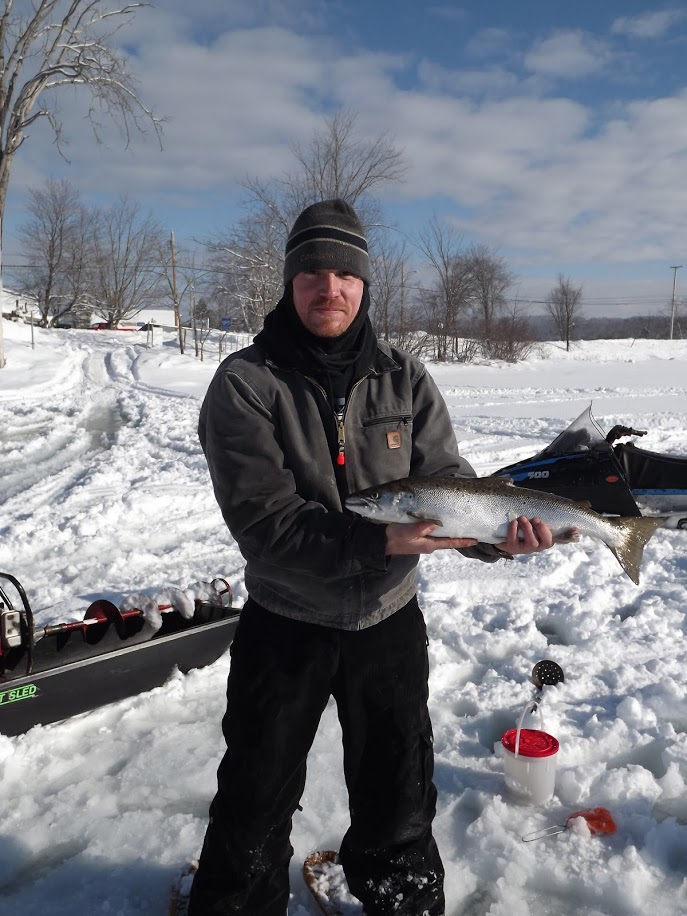March 31, 2017 at 1:58 pm
[caption id="attachment_2225" align="alignright" width="458"] A nice wassookeag lake trout.[/caption]
By Wes Ashe, IFW Fisheries Biologist
Wassookeag Lake is a 1200-acre water located in the northeast corner of Region B. Unlike other lakes in the Sebasticook drainage, Wassookeag is a deep, oligotrophic bowl with excellent water quality, a robust rainbow smelt forage, a sizeable wild togue population, and an exciting landlocked salmon fishery. Wassokeag is an abosolute gem of a coldwater fishery.
This past fall, Region B fisheries biologists set trap nets along the togue spawning shoal in an attempt to assess the health and status of Wassookeag’s wild population. It was a routine set, and as in year’s past, we fully anticipated collecting dozens of adult togue. The nets soaked for nearly three weeks at optimal spawning temperatures, and collected 65 impressive landlocked salmon along with many other species including small- and largemouth bass, white sucker, white perch, yellow perch, chain pickerel, rainbow smelt, pumpkinseed sunfish, cusk, and a bucketful of invasive black crappie. Strangely, we collected zero togue, and that was worrisome enough to include Wassookeag on our 2017 winter creel survey schedule. We needed more data.
[caption id="attachment_2226" align="alignleft" width="447"]
A nice wassookeag lake trout.[/caption]
By Wes Ashe, IFW Fisheries Biologist
Wassookeag Lake is a 1200-acre water located in the northeast corner of Region B. Unlike other lakes in the Sebasticook drainage, Wassookeag is a deep, oligotrophic bowl with excellent water quality, a robust rainbow smelt forage, a sizeable wild togue population, and an exciting landlocked salmon fishery. Wassokeag is an abosolute gem of a coldwater fishery.
This past fall, Region B fisheries biologists set trap nets along the togue spawning shoal in an attempt to assess the health and status of Wassookeag’s wild population. It was a routine set, and as in year’s past, we fully anticipated collecting dozens of adult togue. The nets soaked for nearly three weeks at optimal spawning temperatures, and collected 65 impressive landlocked salmon along with many other species including small- and largemouth bass, white sucker, white perch, yellow perch, chain pickerel, rainbow smelt, pumpkinseed sunfish, cusk, and a bucketful of invasive black crappie. Strangely, we collected zero togue, and that was worrisome enough to include Wassookeag on our 2017 winter creel survey schedule. We needed more data.
[caption id="attachment_2226" align="alignleft" width="447"] Biologists monitor fish populations in a variety of ways, including setting trap nets to capture fish like this Wassookeag Lake togue.[/caption]
Wassookeag opened for ice fishing on January 1st, and it was bustling with anxious anglers. Ice conditions weren’t ideal, but they were decent enough to ease our minds. Through creel surveys and angler interviews, fisheries biologists measured nearly a dozen lake trout in the first handful of trips to Wassookeag.
The fish averaged nearly 21” in length and weighed over 3-lbs, with the largest individual measuring just shy of 25” and 5-lbs. We even saw photos of togue close to 10-lbs. Catch rates were on par with historic levels, and togue anglers were very pleased with the fishery. In fact, most diehard Wassookeag togue anglers feel that the fishery is the best it has been in a long time. Our creel survey data corroborates their angling instinct.
Region B fisheries biologists are still puzzled by the absence of togue in our fall trap nets. Whether it was the drought conditions, water temperature, or some other combination of environmental factors, togue were nowhere to be found. Maybe they spawned early or at a different location? We are unsure. Luckily, trap nets are not only the tool we have to estimate fish populations. We have anglers. Without angler data, fisheries biologists would be forced to evaluate the Wassookeag togue fishery with gillnetting or further trap net sets. But, additional measures are now unnecessary. Based on data provided by you, the anglers, we are confident that the Wassookeag togue population is as healthy and robust as ever.
[caption id="attachment_2228" align="alignleft" width="612"]
Biologists monitor fish populations in a variety of ways, including setting trap nets to capture fish like this Wassookeag Lake togue.[/caption]
Wassookeag opened for ice fishing on January 1st, and it was bustling with anxious anglers. Ice conditions weren’t ideal, but they were decent enough to ease our minds. Through creel surveys and angler interviews, fisheries biologists measured nearly a dozen lake trout in the first handful of trips to Wassookeag.
The fish averaged nearly 21” in length and weighed over 3-lbs, with the largest individual measuring just shy of 25” and 5-lbs. We even saw photos of togue close to 10-lbs. Catch rates were on par with historic levels, and togue anglers were very pleased with the fishery. In fact, most diehard Wassookeag togue anglers feel that the fishery is the best it has been in a long time. Our creel survey data corroborates their angling instinct.
Region B fisheries biologists are still puzzled by the absence of togue in our fall trap nets. Whether it was the drought conditions, water temperature, or some other combination of environmental factors, togue were nowhere to be found. Maybe they spawned early or at a different location? We are unsure. Luckily, trap nets are not only the tool we have to estimate fish populations. We have anglers. Without angler data, fisheries biologists would be forced to evaluate the Wassookeag togue fishery with gillnetting or further trap net sets. But, additional measures are now unnecessary. Based on data provided by you, the anglers, we are confident that the Wassookeag togue population is as healthy and robust as ever.
[caption id="attachment_2228" align="alignleft" width="612"] Along with lake trout, Wassookeag also produces some nice salmon like this one caught by Justin Limoges.[/caption]
[caption id="attachment_2224" align="alignright" width="683"]
Along with lake trout, Wassookeag also produces some nice salmon like this one caught by Justin Limoges.[/caption]
[caption id="attachment_2224" align="alignright" width="683"] Wassookeag Lake attracts a number of anglers, including camp owners and day trippers.[/caption]
Wassookeag Lake attracts a number of anglers, including camp owners and day trippers.[/caption]
 A nice wassookeag lake trout.[/caption]
By Wes Ashe, IFW Fisheries Biologist
Wassookeag Lake is a 1200-acre water located in the northeast corner of Region B. Unlike other lakes in the Sebasticook drainage, Wassookeag is a deep, oligotrophic bowl with excellent water quality, a robust rainbow smelt forage, a sizeable wild togue population, and an exciting landlocked salmon fishery. Wassokeag is an abosolute gem of a coldwater fishery.
This past fall, Region B fisheries biologists set trap nets along the togue spawning shoal in an attempt to assess the health and status of Wassookeag’s wild population. It was a routine set, and as in year’s past, we fully anticipated collecting dozens of adult togue. The nets soaked for nearly three weeks at optimal spawning temperatures, and collected 65 impressive landlocked salmon along with many other species including small- and largemouth bass, white sucker, white perch, yellow perch, chain pickerel, rainbow smelt, pumpkinseed sunfish, cusk, and a bucketful of invasive black crappie. Strangely, we collected zero togue, and that was worrisome enough to include Wassookeag on our 2017 winter creel survey schedule. We needed more data.
[caption id="attachment_2226" align="alignleft" width="447"]
A nice wassookeag lake trout.[/caption]
By Wes Ashe, IFW Fisheries Biologist
Wassookeag Lake is a 1200-acre water located in the northeast corner of Region B. Unlike other lakes in the Sebasticook drainage, Wassookeag is a deep, oligotrophic bowl with excellent water quality, a robust rainbow smelt forage, a sizeable wild togue population, and an exciting landlocked salmon fishery. Wassokeag is an abosolute gem of a coldwater fishery.
This past fall, Region B fisheries biologists set trap nets along the togue spawning shoal in an attempt to assess the health and status of Wassookeag’s wild population. It was a routine set, and as in year’s past, we fully anticipated collecting dozens of adult togue. The nets soaked for nearly three weeks at optimal spawning temperatures, and collected 65 impressive landlocked salmon along with many other species including small- and largemouth bass, white sucker, white perch, yellow perch, chain pickerel, rainbow smelt, pumpkinseed sunfish, cusk, and a bucketful of invasive black crappie. Strangely, we collected zero togue, and that was worrisome enough to include Wassookeag on our 2017 winter creel survey schedule. We needed more data.
[caption id="attachment_2226" align="alignleft" width="447"] Biologists monitor fish populations in a variety of ways, including setting trap nets to capture fish like this Wassookeag Lake togue.[/caption]
Wassookeag opened for ice fishing on January 1st, and it was bustling with anxious anglers. Ice conditions weren’t ideal, but they were decent enough to ease our minds. Through creel surveys and angler interviews, fisheries biologists measured nearly a dozen lake trout in the first handful of trips to Wassookeag.
The fish averaged nearly 21” in length and weighed over 3-lbs, with the largest individual measuring just shy of 25” and 5-lbs. We even saw photos of togue close to 10-lbs. Catch rates were on par with historic levels, and togue anglers were very pleased with the fishery. In fact, most diehard Wassookeag togue anglers feel that the fishery is the best it has been in a long time. Our creel survey data corroborates their angling instinct.
Region B fisheries biologists are still puzzled by the absence of togue in our fall trap nets. Whether it was the drought conditions, water temperature, or some other combination of environmental factors, togue were nowhere to be found. Maybe they spawned early or at a different location? We are unsure. Luckily, trap nets are not only the tool we have to estimate fish populations. We have anglers. Without angler data, fisheries biologists would be forced to evaluate the Wassookeag togue fishery with gillnetting or further trap net sets. But, additional measures are now unnecessary. Based on data provided by you, the anglers, we are confident that the Wassookeag togue population is as healthy and robust as ever.
[caption id="attachment_2228" align="alignleft" width="612"]
Biologists monitor fish populations in a variety of ways, including setting trap nets to capture fish like this Wassookeag Lake togue.[/caption]
Wassookeag opened for ice fishing on January 1st, and it was bustling with anxious anglers. Ice conditions weren’t ideal, but they were decent enough to ease our minds. Through creel surveys and angler interviews, fisheries biologists measured nearly a dozen lake trout in the first handful of trips to Wassookeag.
The fish averaged nearly 21” in length and weighed over 3-lbs, with the largest individual measuring just shy of 25” and 5-lbs. We even saw photos of togue close to 10-lbs. Catch rates were on par with historic levels, and togue anglers were very pleased with the fishery. In fact, most diehard Wassookeag togue anglers feel that the fishery is the best it has been in a long time. Our creel survey data corroborates their angling instinct.
Region B fisheries biologists are still puzzled by the absence of togue in our fall trap nets. Whether it was the drought conditions, water temperature, or some other combination of environmental factors, togue were nowhere to be found. Maybe they spawned early or at a different location? We are unsure. Luckily, trap nets are not only the tool we have to estimate fish populations. We have anglers. Without angler data, fisheries biologists would be forced to evaluate the Wassookeag togue fishery with gillnetting or further trap net sets. But, additional measures are now unnecessary. Based on data provided by you, the anglers, we are confident that the Wassookeag togue population is as healthy and robust as ever.
[caption id="attachment_2228" align="alignleft" width="612"] Along with lake trout, Wassookeag also produces some nice salmon like this one caught by Justin Limoges.[/caption]
[caption id="attachment_2224" align="alignright" width="683"]
Along with lake trout, Wassookeag also produces some nice salmon like this one caught by Justin Limoges.[/caption]
[caption id="attachment_2224" align="alignright" width="683"] Wassookeag Lake attracts a number of anglers, including camp owners and day trippers.[/caption]
Wassookeag Lake attracts a number of anglers, including camp owners and day trippers.[/caption]
Categories